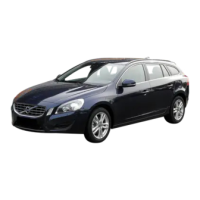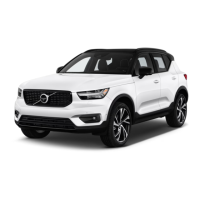
Do you have a question about the Volvo XC40 Twin Engine and is the answer not in the manual?
| Brand | Volvo |
|---|---|
| Model | XC40 Twin Engine |
| Category | Automobile |
| Language | English |
Owner's manual available in the car's centre display.
Owner's manual accessible via a smartphone app.
Online resources for manuals and tutorials.
Supplement in glovebox with practical info.
Personal ID for accessing Volvo services like On Call and map services.
The car's intelligent interface for entertainment and information.
24/7 contact, assistance, and remote functions via app.
Save personalized settings for different drivers.
Set cabin temperature before departure.
Check and save tyre pressure via the Car Status app.
Check oil level and book service via the Car Status app.
Charge the hybrid battery via the input socket.
Automatic angling and retraction of door mirrors.
Lock/unlock the car using the remote control key.
Operate the glass roof with sun blind.
Open/close the tailgate using foot or button.
Operate doors, tailgate, windows, and panic alarm.
How to open the car's charging hatch.
Secure the tailgate for service or hotel stays.
Controls for the central and driver information displays.
Systems for selecting driving style and braking.
Convenience features and safety systems within the cabin.
Change themes and background for centre display.
Return to home view and manage display content.
Lock touch function for safe cleaning.
View network, media, and activity indicators.
Adjust temperature, seat heating, and fan speed.
Location of the charging cable in the cargo area.
Unit shows charging status and has fault breaker.
Steps to connect and start charging the hybrid battery.
Steps to disconnect and secure the charging cable.
LED indicators for charging status at socket, unit, and display.
Indicates approximate remaining range in electric mode.
Symbols for electric motor, engine, and charging status.
Engine operation based on driving needs and battery level.
Controls for seat position and lumbar support.
Save preferred seat and mirror settings to memory buttons.
Steps to fold down rear seat backrests.
Steps to raise and lock rear seat backrests.
Adjusting steering wheel height and depth.
Left/right keypad controls for driver display and functions.
Using voice commands and viewing trip data.
Control headlamps, approach lighting, and home safe lighting.
Reset manual trip meter mileage.
Operate windscreen wipers and rain sensor.
Put wipers in service mode for maintenance.
Use AUTO for automatic temperature and fan control.
Heat or cool the cabin before driving.
Schedule preconditioning for a specific time.
Cleanse cabin air from contaminants.
Connect to the internet via modem, Wi-Fi, or share connection.
Connect phones and devices for calls, media, and charging.
Location and use of 12V power outlets.
Make and receive calls via display or steering wheel.
Play audio and integrate smartphones (CarPlay/Android Auto).
Access maps, set destinations, and update maps.
Control music playback and radio stations.
Make calls, manage contacts, and view call history.
Quick access to recently used features.
Activate/deactivate car functions like Lane Keeping Aid.
Browse and manage installed and downloadable apps.
Download, update, and uninstall apps and system software.
Customize the layout of apps and function buttons.
Configure displays, mirrors, audio, and voice control.
Create and manage individual driver profiles.
Customize driving modes like Hybrid or Pure.
Adjust volume for system sounds and screen taps.
Collision avoidance assistance for vehicles and pedestrians.
Alerts for vehicles in blind spots.
Warns of crossing traffic when reversing.
Helps prevent unintentional lane departures.
Assists steering to avoid collisions or stay in lane.
Maintains lane and distance to vehicle ahead.
Automated assistance for parking manoeuvres.
Instructions for parallel and perpendicular parking.
Use Park Assist Pilot to exit a parallel parking spot.
Camera views and graphics to aid parking.
Charge and precondition car for optimal range.
Tips for efficient driving, like using Pure mode and steady speed.
Factors like traffic and weather affecting range.
Control phone functions using voice.
Control audio playback and radio stations.
Adjust climate settings using voice.
Use voice commands for navigation destinations and guidance.
Important warnings for various car systems and operations.
Safety guidelines for charging and electrical components.
Understanding the limits of driver aids and parking assistance.
Guidelines for car connectivity, modem, and data costs.











